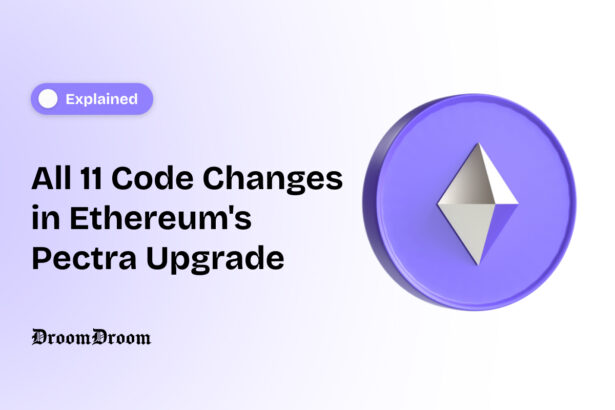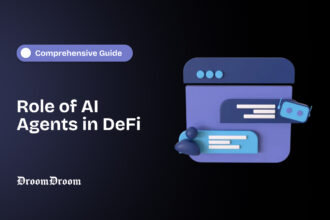The Pectra Upgrade in Ethereum is one of the critical stepping stones for scaling the Ethereum blockchain. The upgrade is a combination of Prague and Electra Upgrades and hence the names.
- EIP 2537 – Faster Digital Signature Verification
- EIP 2935 – Improved Block Fetching
- EIP 6110 – Reducing Validator Onboarding Time
- EIP 7002 – Validator Offboarding Made Easy
- EIP 7521 – Increased Maximum Validator Stake to 2048 ETH
- EIP 7549 – Faster Consensus
- EIP 7623 – Discouraging Older Scaling Methods
- EIP 7685 – Allows Smart Contract to Validator Communication
- EIP 7691 – Increase Blobs per Block to 8 (max)
- EIP 7702 – Smart Accounts
- EIP 7840 – Adjustable Blob Spaces
Pectra not only aims to scale Ethereum but also helps it decentralize further, reduce gas costs, improves memory storage, implements the Verkle Trees, and creates stepping stones for the final scaling operation named Sharding.
This upgrade is the next significant one after the Dencun Upgrade in March 2024 and contains 11 major code changes (Ethereum Improvement Proposal), each of which is proposed and approved in the Ethereum community via a democratic voting mechanism. After the rollout, Ethereum is expected to be a bit more efficient, faster and provide better data storage mechanisms on the blockchain for reduced memory utilization.
Ethereum Pectra Upgrade Explained: How Ethereum Is Scaling for the Future
EIP 2537 – Faster Digital Signature Verification
EIP 2537 is the first major code change in the Pectra Upgrade that streamlines digital signature verifications in the Ethereum blockchain. Digital signatures are done via private keys and are critical in approving transactions like staking, cross-chain asset transfers, and other operations.
These digital signatures were earlier verified via Elliptic Curve Digital Signature Algorithms which uses a regression algorithm to verify signatures, similar to a trial and error method. Earlier the operations were an 80-bit process. The new method uses an efficient BLS signature verification system which still uses the previous Elliptic Curve but at a 120-bit rate.
As a result, such operations will be at least 50% faster in principle.
EIP 2935 – Improved Block Fetching
A node or an external agent (a data compiler, auditor, or an ordinary user) previously could see upto 256 recent block hashes in the blockchain without downloading the entire chain data. This granted them access to a maximum range of last 1 hour of data approximately which became a challenge if someone needs to access the block hash of a block that was created a few hours ago.
With the EIP 2935 in Pectra, the new upgrade now allows users to view the hashes of upto 8191 blocks which roughly corresponds to the blocks created in the last 34 hours (approximately).
This EIP is being seen as a stepping stone to Verkle Trees which are vector enabled Merkle Trees. These trees will help Ethereum become lighter by eliminating the need for downloading every historical block to verify a certain transaction or to see a certain historical block hash.
EIP 6110 – Reducing Validator Onboarding Time
Before the Pectra upgrade, Ethereum’s validator onboarding had to be approved from the Consensus Layer. Other validators would have to approve the 32 ETH deposit required to become a validator. The process took around 9 hours as per Ethereum.
Now with the Pectra Upgrade, this process has been shortened to merely 13 minutes. New validators can get onboarded in a very short time because the validator’s deposited stake will now be approved from the Execution Layer, the same layer that processes all the transactions on Ethereum.
EIP 7002 – Validator Offboarding Made Easy
This EIP of the Pectra Upgrade does just the opposite of EIP 6110, but much faster. It helps validators off-board from Ethereum much faster than before.
When validators off-board from Ethereum, they also withdraw their staked collateral of 32 ETH. This unstaking process has now been moved to the Execution Layer from Consensus Layer just like EIP 6110.
The two upgrades mentioned above are expected to help quick validator onboarding and offboarding, especially in staking pools and delegated validators.
Delegated validators are those who take ETH from others to stake collateral on the Ethereum Node and share the profits to the delegators which they earn from signing transactions.
EIP 7521 – Increased Maximum Validator Stake to 2048 ETH
As discussed previously, Ethereum Validators need to post some collateral to the blockchain network which acts as a security guarantee of their good behavior and stops them from engaging in any kind of manipulation.
The current maximum validator stake was 32 ETH. This forced larger validators to run more virtual nodes just to stake their full amount. This then created the illusion of more validators than actually present.
Further, it created a problem for the validator who had to create multiple node accounts, hire multiple virtual computers, and probably extra staff too to manage them.
With the increased stake limit to 2048 ETH, there will be a consolidation of validators and hopefully, within a few months, we might see the real number of validators active on Ethereum.
Finally, there is also a reduction in the quantum of validator stake slashed for penalties from 1/32th of the total available stake to 1/4096th of the same.
Learn about PayFi, the next major thing in Blockchain Technology after Memecoins and RWA.
EIP 7549 – Faster Consensus
This is a major upgrade that cuts the consensus load from 1300+ votes to just 22 votes. As a result, the blockchain will reach consensus faster and produce blocks much faster.
EIP 7623 – Discouraging Older Scaling Methods
This is also a major upgrade that discourages the use of call data by increasing the fees from 16 to 42 gas per byte. The 300% increase is expected to discourage Layer-2 scaling solutions to use call data (as used earlier) and switch to blobs.
Call data is an empty space in a block where Layer-2 solutions stored their rollup data and the hash of the rollup data was posted on the Ethereum mainnet. They increased the size of each block and therefore Ethereum nodes had to download much more data than the actual size of the blockchain.
With call data-based scaling being history now, this EIP will put an increased focus on using blobs.
EIP 7685 – Allows Smart Contract to Validator Communication
This is a minor code change that allows smart contracts to send requests to validators directly. Though this may not be visible to the end user, it is expected to lay the ground for further complex communications between the two.
EIP 7691 – Increase Blobs per Block to 8 (max)
Currently, Ethereum features around 3 to 4 blobs per block for rollup data storage. Since blob utilization has increased now i.e., 1 year after the Dencun Upgrade, the limit has been increased to a maximum of 8 blobs per block.
Additionally, blob data will now be more accurate which will help in better calculation of blob fees. Volatile and unpredictable blob fees were a major challenge for layer-2 scaling solutions in Ethereum.
EIP 7702 – Smart Accounts
EIP 7702 is the most significant upgrade in the Pectra Upgrade which essentially converts every address into a smart contract-enabled account. This means that ordinary users would be able to create and execute smart contract logic such as automated payouts, escrow, etc., in their accounts.
In the Ethereum blockchain, each address (technically referred to as an account) is either a smart contract account or an Externally Owned Account. The ordinary ETH addresses (which look like 0x4aadbchfgwdwandaoi) are called EOAs.
Other features available are transaction batching, gas sponsorships, and (possibly) socially recoverable accounts. An upcoming feature could allow you different authentication methods in case you lose your private keys.
However, these accounts also suffer from external threats that can alter your smart contract logic.
The Bybit Exchange suffered the largest hack in crypto ($1.5 billion by dollar value) due to one such smart EOA and a compromised user interface.
Explained: How Arbitrum Works? A Key Layer-2 Scaling Solution for Ethereum
EIP 7840 – Adjustable Blob Spaces
This is a minor change that has moved the blob configuration file to Ethereum settings (Yes! Ethereum is based on individual files and has a settings section too). This movement allows Ethereum to adjust blob space with relative ease. As a result, there would be better adjustment of this space when the need arises.




















